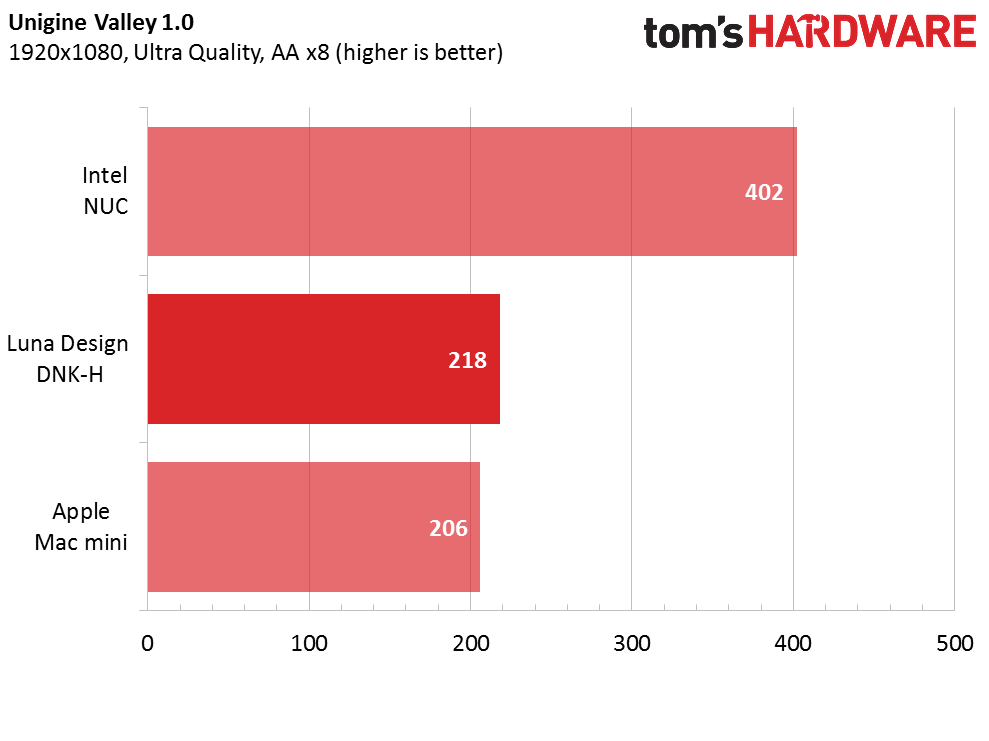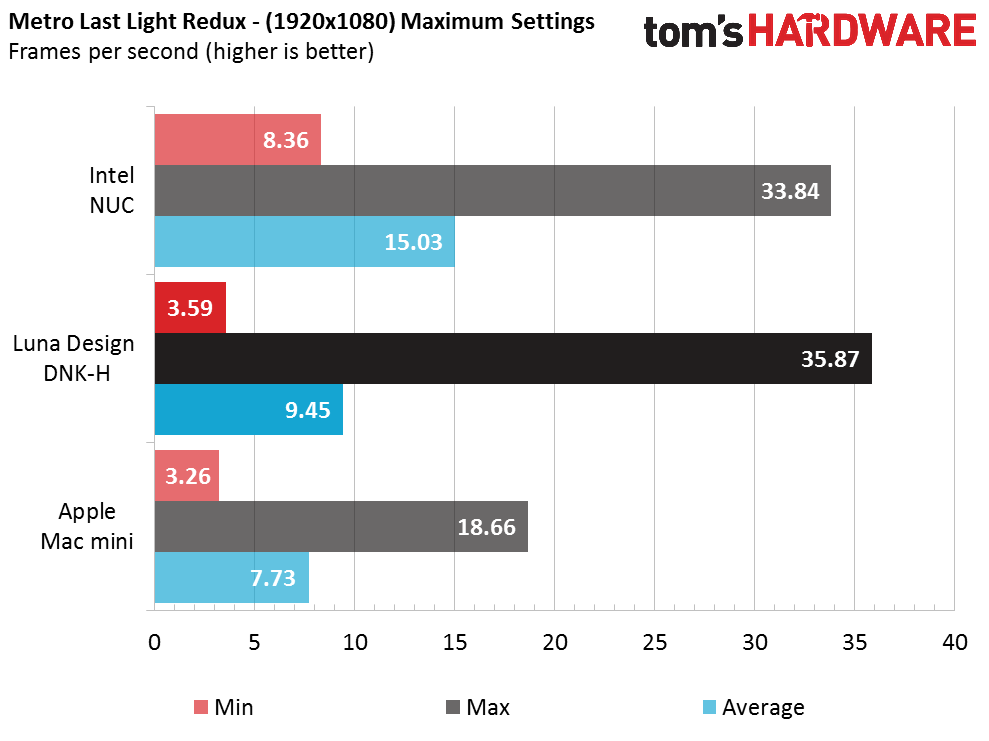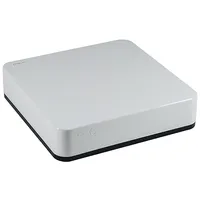First Look: Luna Design DNK-H Slim Mini ITX Case
Benchmarks And Conclusion
How We Tested the DNK-H
We ran the Luna Design DNK-H through our standard First Look suite, with a couple of extra tests added. Our standard test suite consists of PCMark 8, 3DMark Fire Strike, and Unigine Valley for the synthetic tests, as well as the built-in benchmarks in Bioshock Infinite and Metro: Last Light Redux for the gaming tests. Because compact systems are expected to be both cool and quiet, we’ve added CPU thermal testing and noise testing to the mix.
We put the DNK-H up against two other popular and similarly configured systems: Apple’s late-2014 Mac mini and Intel’s Skull canyon NUC.
Synthetic Benchmark – PCMark 8
For our first benchmark we see the DNK-H and the NUC trade blows as the DNK-H’s more powerful desktop CPU comes out on top in the Work test while the NUC’s Iris Pro GPU gives it a distinct advantage in the more GPU-bound Home and Creative tests. Meanwhile, we find Apple’s Mac mini in last place with its aging mobile CPU, which can’t keep up with the modern hardware found in the other two products.
Synthetic Benchmark – 3DMark Fire Strike
Similarly, both the DNK-H and the NUC score well in the CPU-based physics test, with the win going to the DNK-H for its desktop CPU. The limits of all three systems are also rather obvious here, with poor overall graphics scores due to the limitations of their CPU-based GPUs.
Get Tom's Hardware's best news and in-depth reviews, straight to your inbox.
Synthetic Benchmark – Unigine Valley
Once again we see the same pattern, with the NUC’s Intel Iris Pro graphics taking a commanding lead over both the Intel HD graphics in the DNK-H and the aging Intel Iris graphics in the Mac mini.
Gaming Benchmark – Bioshock Infinite
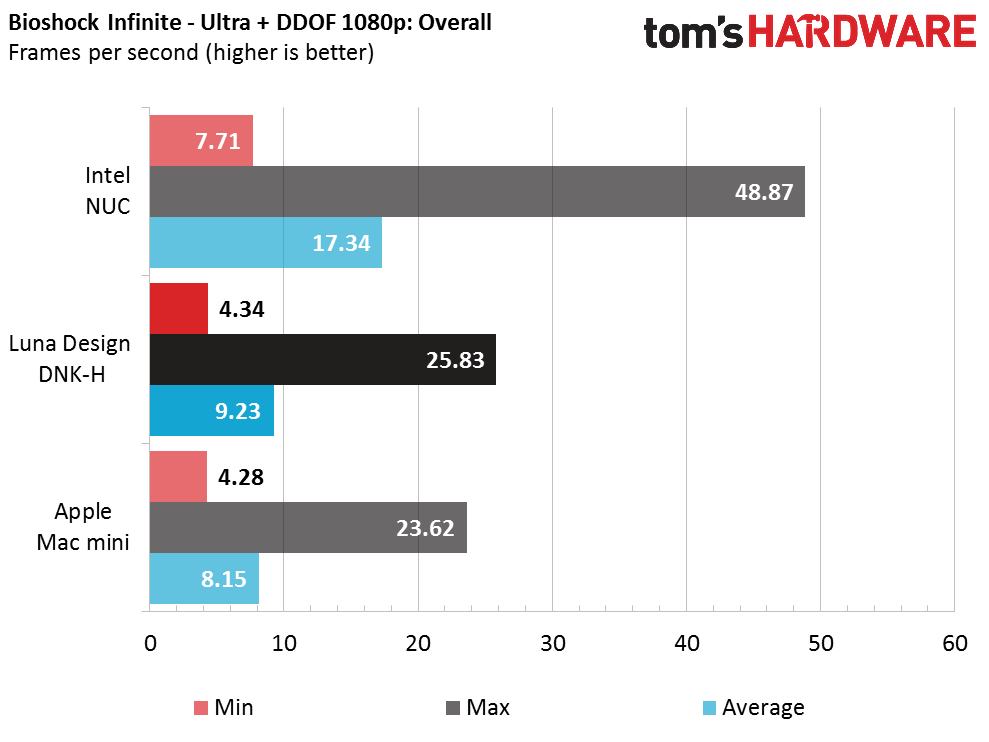
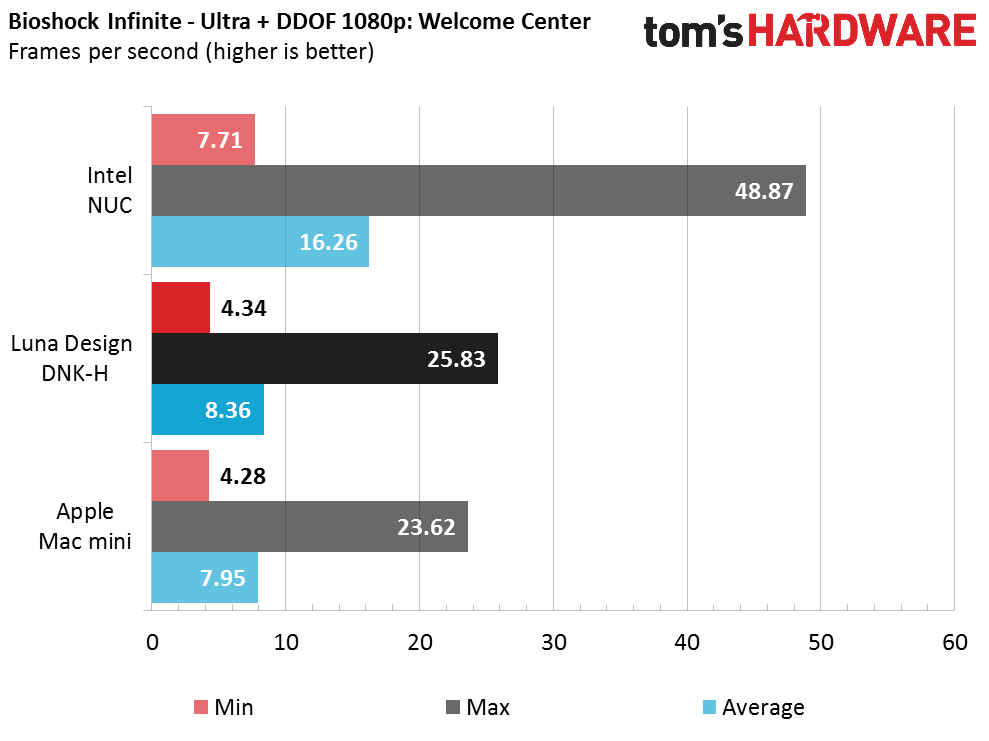
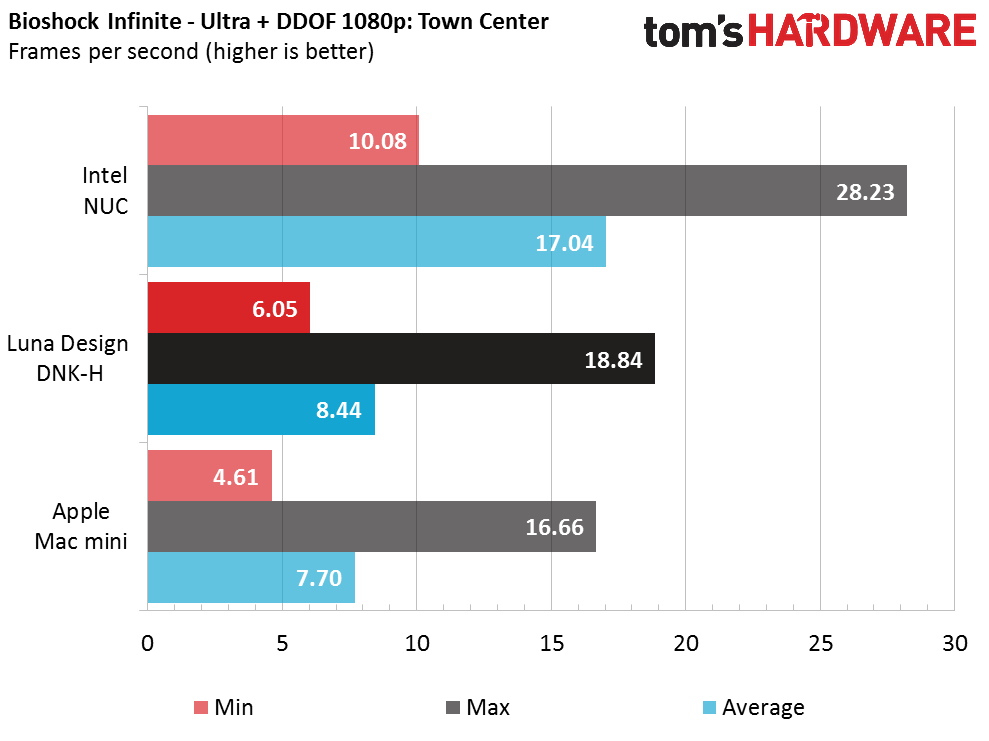

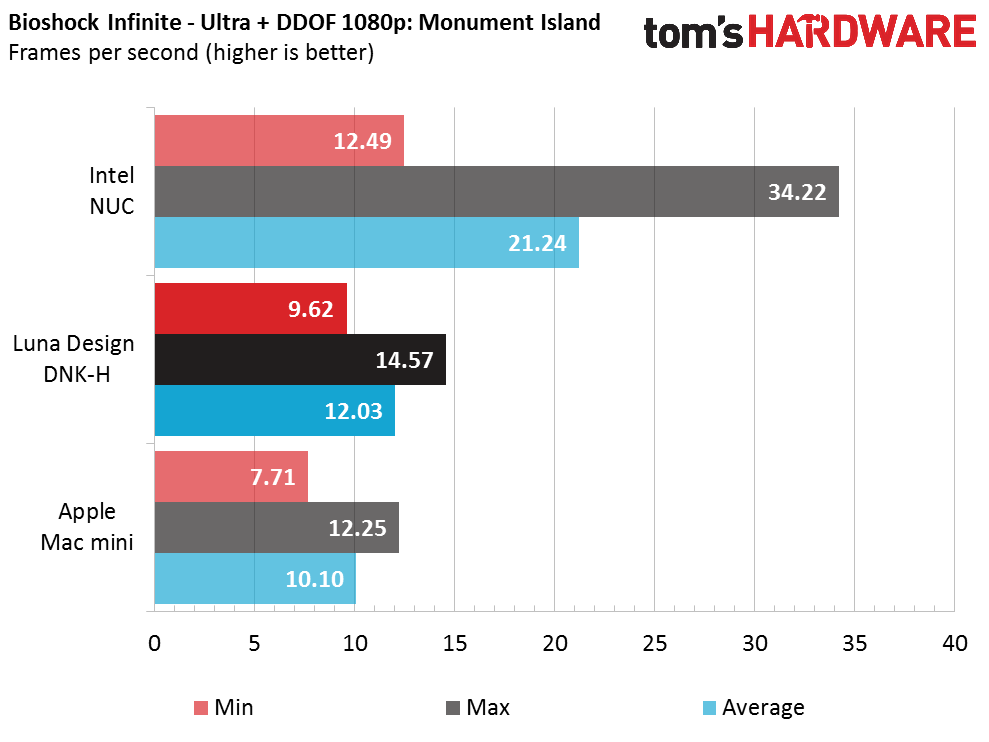
The graphics punishment continues. The Intel NUC is the only system to come close to what we would consider a playable framerate at these settings. Meanwhile we find the other systems drowning in their own blood trying to keep up.
Gaming Benchmark – Metro: Last Light Redux
At this point, Metro: Last Light Redux puts the final nail in the coffin of all three systems, with even the NUC’s Iris Pro graphics succumbing to this benchmark's extreme graphics load.
CPU Thermal Testing
We conducted today’s thermal tests by running both Prime95 (small FFTs) and 3DMark 11’s Graphics Test 1 (extreme preset) for a punishing, full two hours on each system. Then we averaged Tcore temperature from each core to determine the CPU’s overall temperature, from which we subtracted the ambient temperature of the room to derive the final value. The room temperature for today’s tests was maintained at approximately 26°C (78.8°F).
Even after a full two hours of intense load on its 65W TDP Intel Core i7-6700, the DNK-H manages to maintain a somewhat high, but still quite acceptable overall temperature of 83.5°C, mainly thanks to its full-size heatsink and cooling fan. Meanwhile, even with lower TDP processors, the heat pipes and small cooling fans in the Mac mini and NUC leave them roasting with overall temperatures of 92.2°C and 93.6°C respectively.
Fan Noise Testing
Because compact systems should be both cool and quiet, we put all three systems to the test with our Galaxy CM-140 SPL meter. We measured the CPU fan noise of each system by placing the meter 0.25m away from the front left corner of each system, with the meter’s microphone pointed directly at the system’s case. The numbers were then corrected to the 1m industry standard – used by many loudspeaker and fan manufacturers – by subtracting 12 decibels.
All three systems are quiet enough at idle that they managed to push our sound meter to its limits by coming in just under its certified 32 dBA minimum. Short of placing your ear against one of them, you won’t be able to hear them under light loads. Under more intense loads we start to see a marked increase in fan noise. The same cooling solution that left the Mac mini roasting in our temperature test also makes it the quietest system of the three. Meanwhile, we see the DNK-H and NUC trading blows, with the win going to the DNK-H for its lower overall temperatures.
Conclusion
The compact system marketplace is full of options ranging from Apple’s Mac mini, to Intel’s line of NUCs, to fanless systems, and more. Each makes some sort of trade-off between size and features, and almost all carry a hefty price tag. Further complicating matters is the respectable number of Thin Mini-ITX cases on the market for builders looking to build their own systems.
Luna Design’s DNK-H is a great compact system, in the sense that you can either buy the case standalone and build your own system, or have the company build one for you. If you choose to have Luna Design build one for you, you get a great system full of parts that are guaranteed to work together, and if you choose to go it on your own, you still get a great compact case with lots of space, and a built-in cooling system and power supply, all of which is ready to build. Finally, the ability to use a desktop CPU instead of its mobile equivalent should place the DNK-H above a good bit of the competition, especially in the pre-built systems market which is dominated by less capable mobile processors.
Even though the DNK-H is a great system, it won’t be replacing your gaming desktop or laptop any time soon. As a whole, compact systems like the DNK-H usually don't fare well in heavy graphics workloads because they lack a discrete graphics card. Furthermore, the scarcity of desktop CPUs with on-chip, high-performance graphics, and that drop into an LGA socket, make gaming with the DNK-H even more difficult, even with lowered settings.
But at less than $80 for a case and under $1,000 for a pre-built system, the DNK-H is still an excellent buy for anyone who wants a product with a great price-to-performance ratio, as well as a great compact system with a respectable amount of customization.
MORE: Best Cases
MORE: All Case Content
MORE: In Pictures: 40 Unusual Computer Case Mods
-
bit_user Close. I wanted something more airy, with an external PSU (so no fan is needed). I want to pair it with a passively-cooled Apollo Lake board.Reply
Also, the integrated PSU is probably hurting them on the size comparison. Do the others have integrated PSUs?
BTW, I hadn't seen the Intel NUC with the Skull. That's an interesting form of market segmentation. I doubt many corporate users want a computer with a skull on it, regardless of what's inside. -
cmiconi You could probably throw an Apollo Lake board in there and just use the heatsink without the fan. I doubt the CPU is going to get warm enough on its own or pull enough power from the PSU to require active cooling.Reply
The Mac mini uses an integrated PSU, and the NUC uses a power brick.
As for the lovely skull plate on the NUC, Intel already thought ahead and included a plain black top plate, which users can opt to install if they want something more subdued looking. It also comes with a VESA mount for people who'd rather not see it at all. -
bit_user Reply
Look closely, and you'll see there's a fan in the lower section to cool the HDD and integrated PSU. That's what I was talking about. It's probably very quiet, but those seeking a purely-passive solution will skip this one.18801865 said:You could probably throw an Apollo Lake board in there and just use the heatsink without the fan. I doubt the CPU is going to get warm enough on its own or pull enough power from the PSU to require active cooling.
Thanks for the other answers. -
itsmedatguy This is going to be pretty sweet when we start seeing mini ITX boards on the market with thunderbolt 3 (if that's happens) for a cheaper + more powerful NUC alternativeReply -
bit_user Reply
Thanks for pointing that out. I somehow missed that it's mini-ITX, and assumed it was a mini-STX. I guess that explains the integrated PSU, then.18802191 said:This is going to be pretty sweet when we start seeing mini ITX boards on the market with thunderbolt 3 (if that's happens) for a cheaper + more powerful NUC alternative
-
James Mason I kind of hate that you use Ultra settings for integrated graphics, and not include the settings for what it actually can run the games at, because I'm actually impress with it getting 25FPS on ultra in bioshock with just the integrated, I'm curious to see what it would get on the lowest settings as well.Reply -
EpIckFa1LJoN I am currently in the Process of building a console sized gaming computer, complete with a full sized GPU. Using a Silverstone ML08B, just need to find the most powerful graphics card I can fit in it.Reply -
Brian_R170 BIT_USER, the "Skull Canyon" NUC comes with two case covers: one with the skull and one without.Reply -
Brian_R170 Replace the Samsung 950Pro in the NUC with with a 512GB M.2 SATA drive and it brings down the NUC's price by $200 without affecting real-world performance (certainly none of the benchmarks run here). Not sure why anyone would even look at the Luna at that point, at least not the $915 pre-built version.Reply -
bit_user Reply
I think you mean AHCI. SATA is the connector (cable, electrical, etc.), while AHCI (or NVMe) is the command set used by the OS.18810268 said:with a 512GB M.2 SATA drive





